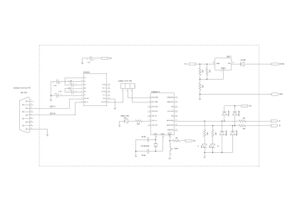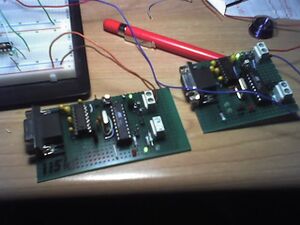Dual channel El Cheapo pulse generator
Contents
So, what is this all about?
For some thing at work it was useful/necessary to generate a not-too-tast, not-too-perfect yet arbitrary long and complex 2-channel digital signal. The thing described here is not that interesting, but can be built in a jiffy (2.5 hours by yours truly, starting from scratch :-) and is really cheap.
The device itself acts as a dumb interpreter/timer of an incoming headerless bitstream (2 bits per sample, ad inifinitum), and outputs samples on each of 2 output-channels (A and B) at fixed intervals.
Hardware
Apart from a fairly uninteresting LM317 regulator and an equally boring Maxim MAX232 level-converter, there is...
Workhorse
Workhorse (although it's burning cycles most of the time) is the faithful ATtiny2313 (although the schematic in fig.1 shows an AT90s2313 there). Input-bitstream comes from a RS232 connection from a host-PC, although a 'self-test' jumper can be closed to have it feed a nice bitstream to itself - mainly useful to test output-levels and -timing. Samples are output as 0V (low) or 5V (high) on 2 pins 'A' and 'B'.
Safety-stuff
This is the 3rd or even 4th unit I had the honour of soldering together; the other ones blew up, quite literally. Looking at fig.1, a diode after the 24VDC-terminal can be seen, as well as 2 clamp-diodes for each channel. In addition, a 4k7 resistor is placed after the clamp-diodes. This prevents damage in case of short-circuit or connecting an output to the gnd- or 24V-rail.
Not exactly a safety-thingie but useful nevertheless: In case of framing error (i.e. serial connector making bad contact, host unplugged, etc), the device halts, and blinks an error-LED. This is a matter of taste, I guess, but ok.
Software
This is the less-boring part, perhaps. Software consists of a real-time part (inside the MCU) and a piece of software on PC that basically feeds the device with a bitstream. The latter can be your average TeraTerm.EXE, or it can be a custom interpreter/generator - I chose the latter.
MCU-software
The bitstream from the PC arrives in an 10-bit frame (startbit + 8N1) @ 115k2. Only 8 useful bits are present in each frame. Since a sample-(pair) consists of 2 bits (1 for each channel, to be output simultaneously), this gives us a sample-rate of ( 115200 / 10 ) * 4 ) ~ 46 kHz = freq_sample. This is not just a Good Idea - it's a fact of life, and follows directly from sample-size (2 bits), frame-layout (10 bits) and serial bit-time ( 1 / 115200 ). We can only output samples at freq_sample Hz using this simple 'bitstream'-method, period.
Therefore, 1 sample-period = ( 1 / freq_sample ) ~ 21.7 usec. Bytes will be arriving (assuming there is no delay between serial frames, i.o.w. each stop-bit is immediately followed by the start-bit for the next frame) at ( (1 / 115200 ) * 10 ) ~ 86.8 usec = ( 1 / freq_frame ). This makes sense, since freq_sample = ( 4 * freq_frame ), since there are 4 samples in a frame. Lovely.
The software will basically do the following:
wait for a byte, then, 4 times in a row, snoop the next 2 sample-bits from the byte at freq_sample. After that, the cycle repeats when a new byte comes in.
To do this, 2 interrupts -'Rx-complete' and a timer - are used. The timer interrupt is normally disabled, but when enabled, is executed when a user-writable, but automatically incrementing timer-register tmr_count overflows/wraps.
Pseudo-code for the RXC-handler:
RXC_ISR()
{
sample_byte = receive_from_serial();
num_remaining_sample = 4;
tmr = T_first;
enable_timer_interrupt();
}
Pseudo-code for the timer-handler:
TMR_ISR()
{
bit_for_chan_A = sample_byte & 1;
bit_for_chan_B = !!( sample_byte & 1 );
output_dual_channel_sample( bit_for_chan_A, bit_for_chan_B );
if ( --num_remaining_sample ) {
tmr = T_next_sample;
}
else {
disable_timer_interrupt();
}
}
An that's basically all. Meanwhile, the main()-routine is keeping itself busy by stuffing 0x78-bytes our of its serial port (which give a fairly interesting gray'ish pattern when viewed on a scope). When aforementioned jumper is set to test-mode, this pattern will be output on channels A and B.
PC-software (interpreter/generator)
= Pattern-definition language grammar
Fuzzy BNF-grammar of the 'language' is as follows:
Program ::= Macro* Macro ::= 'def' NL Statement* 'enddef' NL Statement ::= Hi | Lo | Emit | MacroInstance | Repetition Hi ::= 'hi' <pin> NL Lo ::= 'lo' <pin> NL Emit ::= 'emit' [<count>] NL MacroInstance ::= 'do' <macro_name> NL Repetition ::= 'rep' [<count>] NL Statement* 'endrep' NL NL ::= '\n'
Actually I CBA to think of a name for the 'language'; Pattern Definition Format sounds nice, but somehow I think I saw that before already, hmm... Perhaps Pattern Notation Grammar is something? Or what about Cconsise Pattern Presentation? Hmmm, no, no, no. Oh well. :-)
An example pattern-definition
Behold, a simple program to do the following:
- blink LED on channel A 5 times @ 1Hz,
- output 1000 cycles of 'Ab', 'AB', 'aB', 'ab' (uppercase = channel-output high; lowercase = channel-output low),
- blink the LED forever @ 1Hz.
Although this is a trivial example, it demonstrates the use of repetition, comments and (nested) macros. And yes, I happen to like whitespace. :-)
#
# Simple program to blink led, output pattern, and blink LED forever
#
def DelayHalfSec
# Emit last sample for 23k periods @ 46kHz ~ 0.5 s
emit 23000
enddef
def BlinkOnce
# Turn LED at channel A on, and keep it on for a while
hi 0
emit
do DelayHalfSec
# Turn it off, and keep it off for a while
lo 0
emit
do DelayHalfSec
enddef
def Blink5Times
rep 5
do BlinkOnce
endrep
enddef
def OutputSingleGrayCycle
# (surrounding code makes sure that on entry, both channels are LOW)
hi 0
emit
hi 1
emit
lo 0
emit
lo 1
emit
enddef
def OutputAllGrayCycles
rep 1000
do OutputSingleGrayCycle
endrep
enddef
def main
do Blink5Times
do OutputAllGrayCycles
rep
do BlinkOnce
endrep
# (never reaches here)
enddef
So... what does it look like?
Well, see fig.2 for an idea. 24VDC, gnd and both channels A and B can be connected using screw-terminals. Serial DE-9 is glued onto the board using superglue. The underside (not shown here) is just solder and copper; best kept on a non-conducting desk ;-)
Drawbacks
2 things that are sub-optimal perhaps are...
- samples are output at discrete intervals (46 kHz); i.e. it's impossible to make a clean 40 kHz pattern
- there should not be gaps in between serial frames. A good old 16550A with a 4k Tx-buffer on a non-ancient PC should have no problems with this; however, I've seen USB-to-serial converters screw this up on 2 occasions. Depending on the application this might or might not be a problem.
Have fun -- Michai

